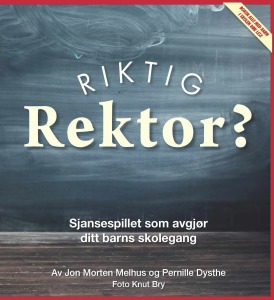The serious business of classroom fun
Fra Horten Videregående. Foto: Knut Bry, fra «Riktig Rektor»
Av Cheryl Mizerny
Morsom undervisning er alvorlige saker
Jeg skal innrømme det: Jeg liker å være kjent som en av de «morsomme» lærere i skolen. Jeg får et lite løft når elevene kommer inn og det første de sier er: «Jeg hørte engelsk var gøy i dag. Jeg gleder meg!» Det gir meg stor tilfredsstillelse å vite at elevene mine ser frem til undervisningen og at de ofte deler med sine foreldre hva vi gjør på skolen. Dette er ikke noe som skjer tilfeldig. Jeg jobber bevisst for å presentere stoffet på måter som ikke bare er effektive, men også underholdende. Det gir meg uendelig glede å høre deres fnising midt i en aktivitet. Det er en av grunnene til at jeg fortsetter å elsker jobben min, selv etter alle disse årene.
Dessverre deler ikke alle lærere min filosofi.
I’ll admit it: I enjoy being known as one of the “fun” teachers in school. I get a little lift when they walk in and the first thing they say is, “I heard English was fun today. I’m excited.” It gives me great satisfaction to know that my students enjoy coming to class and that they often share what we do with their parents when they get home. This doesn’t happen by accident. I consciously work to present material in ways that are not only effective, but also enjoyable. It gives me infinite pleasure to hear their giggles in the middle of an activity. It’s one of the reasons I continue to love my job even after all of these years.
Unfortunately, not every teacher shares my philosophy. Some are under the misconception that students enjoy a class because it is fun and no real learning is involved. They don’t believe that students can possibly be engaged in rigorous educational endeavors if they are laughing, moving and talking. This is absolutely not the case. Just because it’s fun doesn’t mean it’s easy.
To some teachers, rigor — by the way, I hate that word when applied to education — just means hard. It means worksheet packets or excessive problems assigned every night, including weekends and vacations. It means the teacher drones on and on while requiring students to take copious amounts of notes. It means rote learning and very little critical thinking. It means they are not allowed to “help” each other learn. It means the child’s interest in or connection to the material is irrelevant. It means assignments that might be beyond the reach of their students. It means that many students fail their tests. This is why so many education writers speak of “grit.” It would take real fortitude to tough it out in the classroom described above. Children wouldn’t need grit if the task weren’t such drudgery. The bottom line is this: If many students dislike a class, they are not learning as much as they could be.
I strongly believe in what two of my edu-heroes say about rigor. Both Kylene Beers and Harvey Daniels say that there can be rigor without rigor mortis. The first time I heard each of them say that, I wrote it down in my notebook with a huge exclamation point next to it, and I’ve never forgotten it. It truly speaks to the essence of my teaching.
How do I achieve a high level of rigor without killing the love of learning? Simple. I put myself in my students’ shoes. I figure that if I am bored while designing learning opportunities, they will surely tune out. Every time I sit through a mind-numbing professional development day, I vow to keep this at the forefront when outlining a unit. I think about how I would want to learn and what keeps me interested.
In my experience, there are several facets to “edutainment” and the best lessons incorporate as many as possible.
- Humor: No one is asking teachers to become Jon Stewart, but he does present challenging material on a nightly basis in an entertaining way, albeit on an adult level. By finding the humor in what the students consider mundane, teachers will be able to engage as well as inform. While humor cannot be found in every topic we teach, the more often we can find the fun, the more effective our instruction.
- Novelty: It is true that children thrive on structure. In my class, that translates to our sacred 10 minutes of silent reading at the beginning of every class. Beyond that, I rarely do the same thing two days in a row. Students get a little thrill in not knowing exactly what comes next. I’m not the only one who believes this. When I read Teach Like a Pirate by Dave Burgess, I was invigorated by the various “hooks” he presented as methods to engage students and ignite passion in both the teacher and the kids. Similar to Howard Gardner’s Entry Points, Burgess provides techniques for incorporating art, drama, story, and movement to introduce new material and keep the students on the edge of their seats wondering what the teacher will do next.
- Ownership: Earlier this year, I had tremendous success with student-designed Passion Projects. These self-directed research and design projects held their attention for several months. In the feedback I received from students, many said it was one of the most enjoyable things they had ever done in school. It took very little preparation on my part. All I had to do was give them the opportunity and time. They had a blast and learned valuable skills in the process. It was such a hit that we are beginning round two next week. It doesn’t only apply to something as a long-term endeavor. To the greatest extent possible, I incorporate choice into every lesson we do.
- Relevance: Provide some sort of real-world connection to the material. This works especially well if the examples are bizarre, hilarious or shocking. When the students see how the concepts they are learning have application to their daily lives or are evident in the world around them, they get much more excited to complete the necessary work to be successful.
- Collaboration: I teach adolescents. That means I would constantly be fighting a losing battle by forcing them to keep to themselves and remain quiet every day. Human beings are social by nature, and none more so than teens and tweens. By incorporating “legal” opportunities for them to chat, I find that, when they do talk in class, they are mostly on task. Between small group and whole class discussion, they talk much more than I do, and I wouldn’t have it any other way.
- Activity: The school days when I am most miserable are the days when no students are present– professional development days. It is not that I don’t enjoy the learning; I do. It is the act of being forced to sit in a hard, unforgiving chair for 8 hours with very few breaks that makes me want to act out and be disruptive. Imagine how awful it is when we ask beings with the metabolism of rabbits to sit still, be silent and avoid playing with things at their desk. I’m not saying we need to incorporate a calisthenics program, but allowing them to move from station to station, cross the room to look at a display, use hand movements to reinforce concepts, or even just rotate seats, will go a long way toward releasing some of the pent-up need for movement. On the days when sitting still is required, at least provide some sort of fidget toy for them to expend some of that energy.
- Critical thinking: Some of the most enjoyable times I have in class are the days when we do collaborative inquiry lessons. Students work together, using inductive and deductive reasoning, to determine solutions to the task at hand. An added bonus to this type of learning is that the material is more cemented in their minds because they were active participants in the learning.
A fun classroom does not mean that students aren’t learning. It means that they are learning in the ways that meet their needs. It also doesn’t mean that only natural comedians will be successful teachers. It merely means designing lessons with the kids in mind. The side effect is that kids have a great time and maybe even learn something in the process — no grit required. So the next time you hear laughter coming from the classroom of the teacher next door, please don’t assume the students are goofing around. Mine aren’t.
April 13th, 2015
Cheryl Mizerny is an Editor’s Choice Content Award winner. She is a veteran educator with over 20 years experience. She began her career in special education, became a teacher consultant and adjunct professor of educational psychology, and currently teaches sixth-grade English in Bloomfield Hills, Mich. She writes a blog about student motivation and engagement at The Accidental English Teacher.

SKOLEFORDRAGET «GOD LEDER, GOD LÆRER»
Vi tilbyr begeistrende faglige skoleforedrag for både skoleledere og alle medarbeiderne på skolen – les mer her.





